
1.栈
1.1栈的概念及结构
栈:一种特殊的线性表,其只允许在固定的一端进行插入和删除元素操作。进行数据插入和删除操作的一端称为栈顶,另一端称为栈底。栈中的数据元素遵守后进先出LIFO(Last In First Out)的原则。
压栈:栈的插入操作叫做进栈/压栈/入栈,入数据在栈顶。
出栈:栈的删除操作叫做出栈。出数据也在栈顶
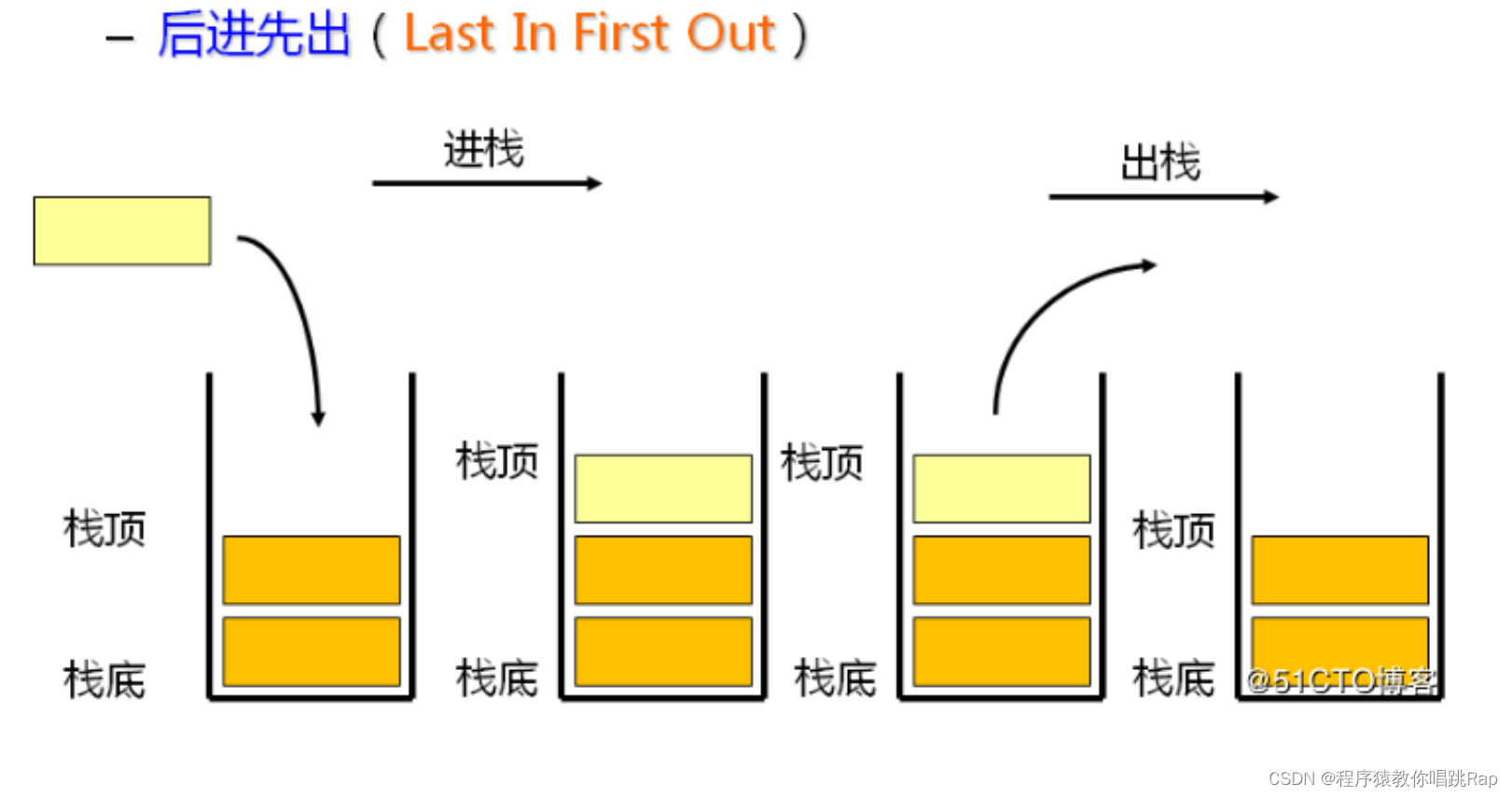
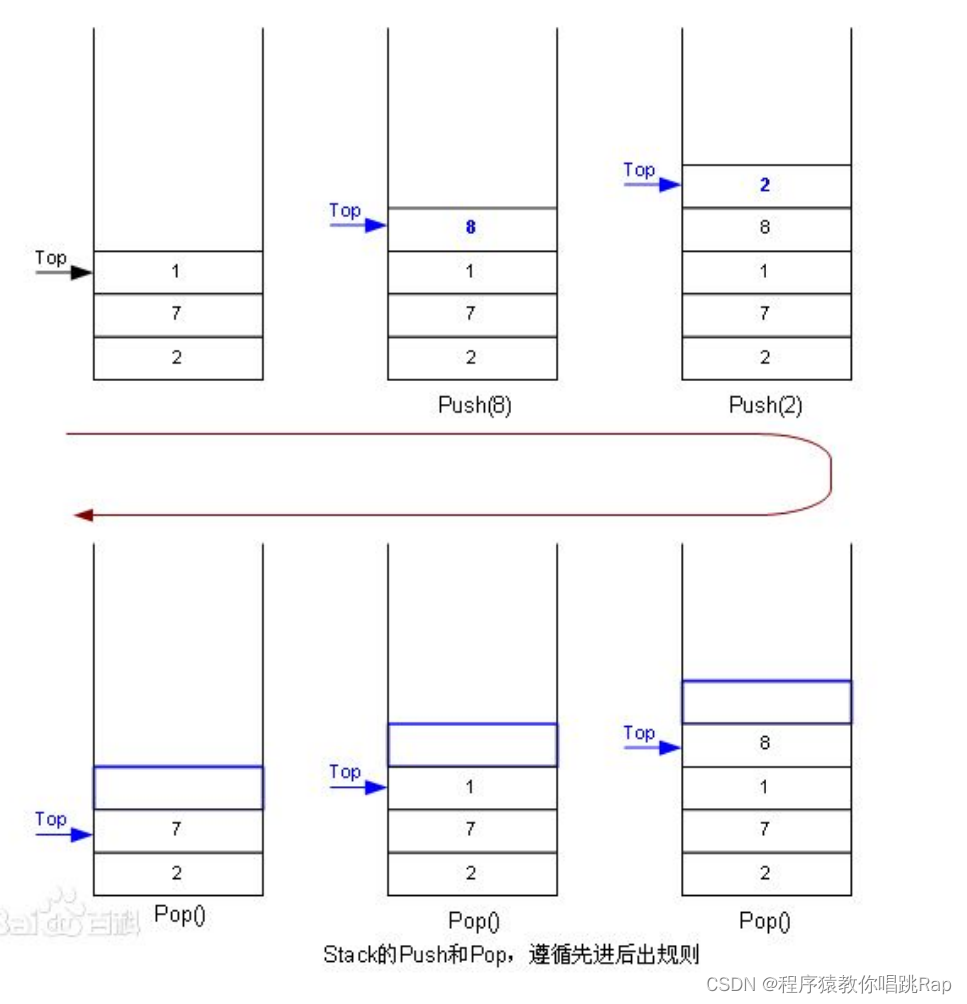
1.2栈的实现
栈的实现一般可以使用数组或者链表实现,相对而言数组的结构实现更优一些。因为数组在尾上插入数据的
代价比较小。

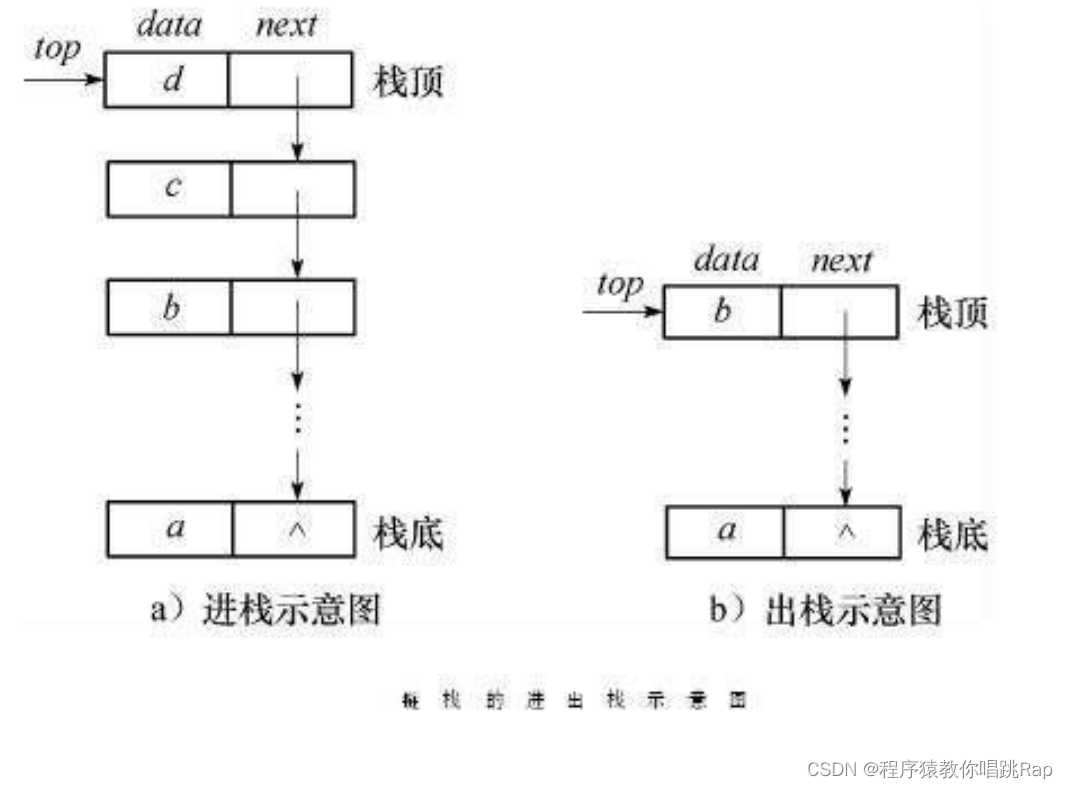
首先在VS里面的源文件建立test.c和Stack.c,在头文件里面建立Stack.h
Stack.h:
#pragma once
#include <stdio.h>
#include <stdlib.h>
#include <assert.h>
#include <stdbool.h>
typedef int STDataType;
typedef struct stack
{
STDataType* a;
int top;
int capacity;
}ST;1.2.1初始化
Stack.h
void stackInit(ST* ps);//初始化Stack.c
#include "Stack.h"
void stackInit(ST* ps)
{
assert(ps);
ps->a = NULL;
ps->top = 0;//也可以是ps->top=-1;
ps->capacity = 0;
}
本文采用top=0
1.2.2 销毁
Stack.h
void stackDestroy(ST* ps);//销毁Stack.c
void stackDestroy(ST* ps)
{
assert(ps);
free(ps->a);
ps->a = NULL;
ps->capacity = ps->top = 0;
}1.2.3 入栈
Stack.h
void stackPush(ST* ps, STDataType x);//入栈Stack.c
void stackPush(ST* ps, STDataType x)
{
assert(ps);
//考虑扩容
if (ps->top == ps->capacity)
{
int newCapacity = ps->capacity == 0 ? 4 : ps->capacity * 2;
ps->a = (STDataType*)relloc(ps->a, sizeof(STDataType)*newCapacity);
if (ps->a == NULL)
{
printf("realloc fail\n");
exit(-1);
}
ps->capacity = newCapacity;//更新容量
}
ps->a[ps->top] = x;//将数据压进去
ps->top++;//栈顶上移
}test.c
#include "Stack.h"
void TestStack()
{
ST st;
stackInit(&st);
stackPush(&st, 1);
stackPush(&st, 2);
stackPush(&st, 3);
}
int main()
{
TestStack();
return 0;
}调试结果:
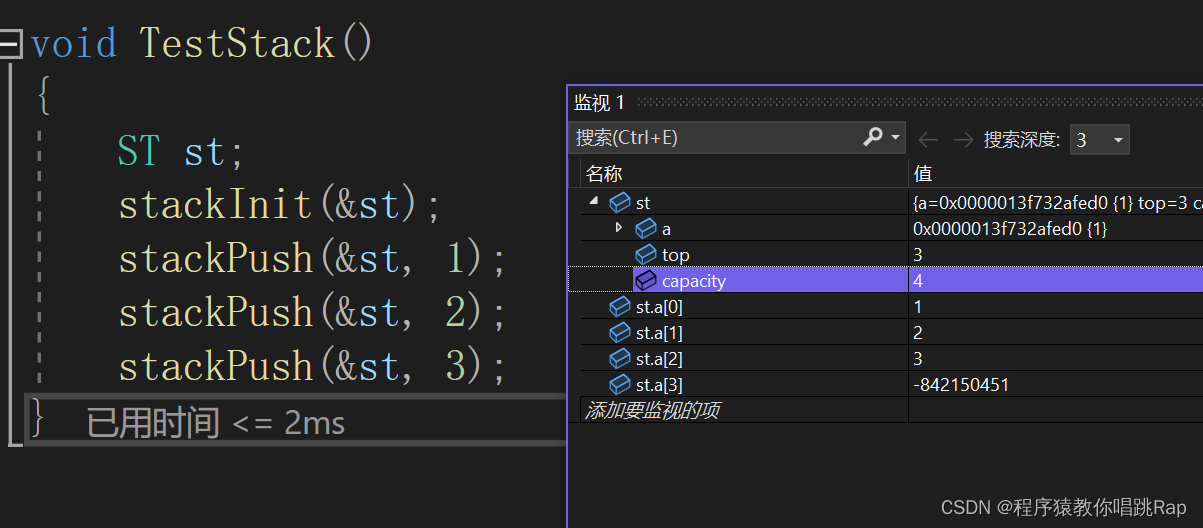
1.2.4 出栈
Stack.h
void stackPop(ST* ps);//出栈Stack.c
//出栈之前要确保top不为空,因此需要断言top>0
void stackPop(ST* ps)
{
assert(ps);
assert(ps->top > 0);
ps->top--;
}test.c
#include "Stack.h"
void TestStack()
{
ST st;
stackInit(&st);
stackPush(&st, 1);
stackPush(&st, 2);
stackPush(&st, 3);
stackPop(&st);
}
int main()
{
TestStack();
return 0;
}调试过程:
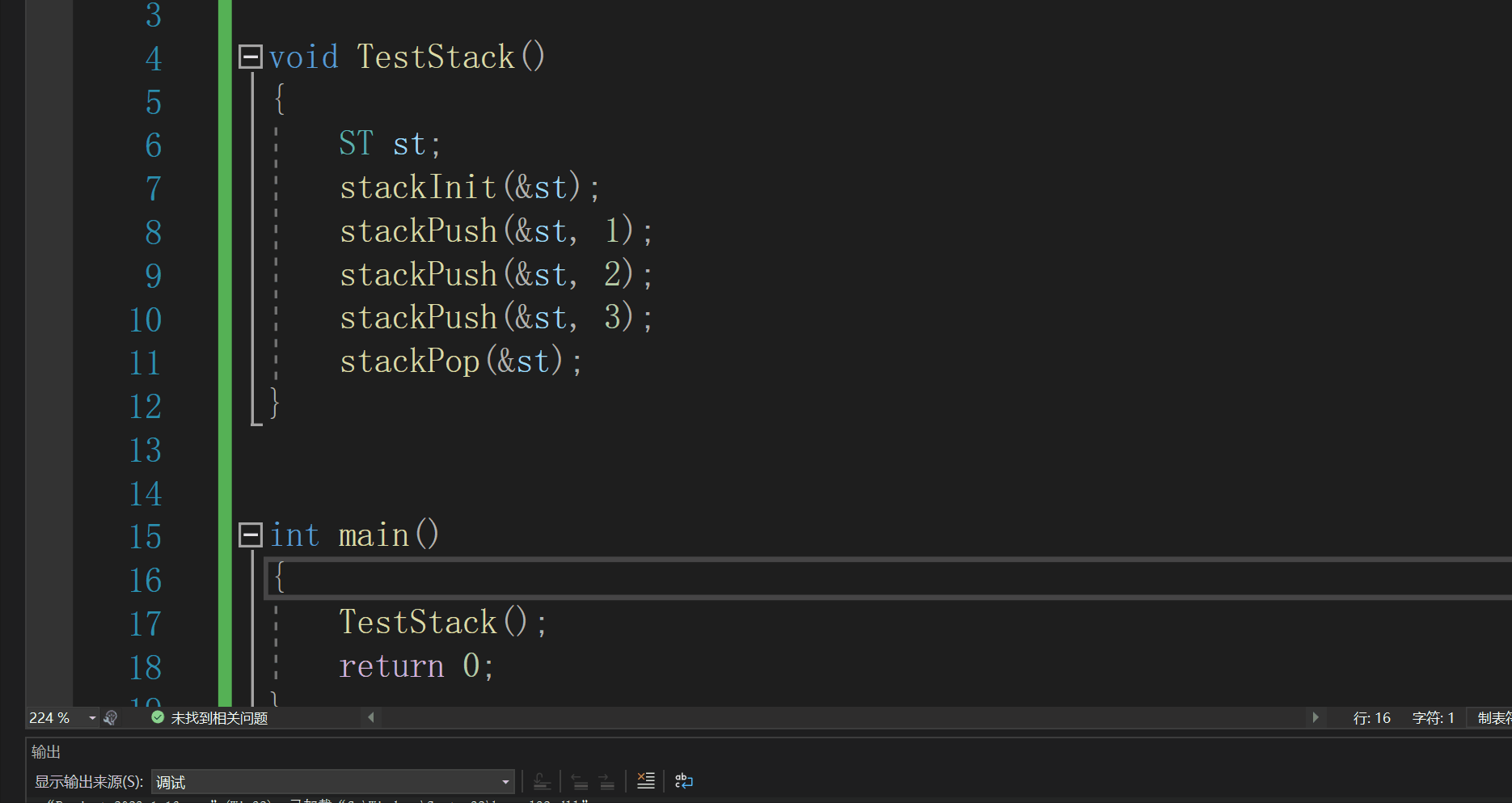
1.2.5 判空
Stack.h
bool stackEmpty(ST* ps);//判断是否为空Stack.c
bool stackEmpty(ST* ps)
{
assert(ps);
return ps->top == 0;//如果top为0,那就是为真,直接返回
}1.2.6 获取栈顶元素
Stack.h
STDataType stackTop(ST* ps);//取栈顶数据Stack.c
//由于本文采用top=0,先压栈,top再++,因此top-1才是栈顶元素。
STDataType stackTop(ST* ps)
{
assert(ps);
assert(ps->top > 0);
return ps->a[ps->top - 1];//top-1才是栈顶元素
}1.2.7 获取栈中的有效元素个数
Stack.h
int stackSize(ST* ps);//栈的有效元素个数Stack.c
//这里需要注意的是,栈顶元素是下标top-1,跟数组一样,总个数是top,而不是top-1
int stackSize(ST* ps)
{
assert(ps);
return ps->top;//不是top-1
}1.3 完整代码展示
Stack.h
#pragma once
#include <stdio.h>
#include <stdlib.h>
#include <assert.h>
#include <stdbool.h>
typedef int STDataType;
typedef struct stack
{
STDataType* a;
int top;
int capacity;
}ST;
void stackInit(ST* ps);//初始化
void stackDestroy(ST* ps);//销毁
void stackPush(ST* ps, STDataType x);//入栈
void stackPop(ST* ps);//出栈
STDataType stackTop(ST* ps);//取栈顶数据
int stackSize(ST* ps);//栈的大小
bool stackEmpty(ST* ps);//判断是否为空Stack.c
#include "Stack.h"
void stackInit(ST* ps)
{
assert(ps);
ps->a = NULL;
ps->top = 0;//指向初始值的下一个
ps->capacity = 0;
}
void stackDestroy(ST* ps)
{
assert(ps);
free(ps->a);
ps->a = NULL;
ps->capacity = ps->top = 0;
}
void stackPush(ST* ps, STDataType x)
{
assert(ps);
if (ps->top == ps->capacity)
{
int newCapacity = ps->capacity == 0 ? 4 : ps->capacity * 2;
STDataType* tmp = (STDataType*)realloc(ps->a, sizeof(STDataType)*newCapacity);
if (tmp == NULL)
{
printf("realloc fail\n");
exit(-1);
}
ps->a = tmp;
ps->capacity = newCapacity;
}
ps->a[ps->top] = x;
ps->top++;
}
void stackPop(ST* ps)
{
assert(ps);
assert(ps->top > 0);
ps->top--;
}
bool stackEmpty(ST* ps)
{
assert(ps);
return ps->top == 0;
}
STDataType stackTop(ST* ps)
{
assert(ps);
assert(ps->top > 0);
return ps->a[ps->top - 1];
}
int stackSize(ST* ps)
{
assert(ps);
return ps->top;
}test.c
#include "Stack.h"
void TestStack()
{
ST st;
stackInit(&st);
stackPush(&st, 1);
stackPush(&st, 2);
stackPush(&st, 3);
stackPop(&st);
}
int main()
{
TestStack();
return 0;
}2.队列
2.1 队列的概念及结构
队列:只允许在一端进行插入数据操作,在另一端进行删除数据操作的特殊线性表,队列具有先进先出FIFO(First In First Out) 入队列:进行插入操作的一端称为队尾 出队列:进行删除操作的一端称为队头

2.2 队列的应用场景
队列:
1.公平排队
2.广度优先遍历
栈:
1.解决括号匹配问题
2.逆波兰表达式求解
3.递归改非递归
2.3 队列的实现
队列也可以数组和链表的结构实现,使用链表的结构实现更优一些,因为如果使用数组的结构,出队列在数组头上出数据,效率会比较低。
首先在VS里面的源文件建立test.c和Queue.c,在头文件里面建立Queue.h
Queue.h
#pragma once
#include <stdio.h>
#include <stdlib.h>
#include <assert.h>
#include <stdbool.h>
//创建队列结构
typedef int QDataType;
//创建队列结点
typedef struct QueueNode
{
struct QueueNode* next;//记录下一个结点
QDataType data;//存储数据
}QNode;
//保存队头和队尾
typedef struct Queue
{
QNode* head;//头指针
QNode* tail;//尾指针
}Queue;2.3.1 初始化
Queue.h
void QueueInit(Queue* pq);//初始化Queue.c
#include "Queue.h"
void QueueInit(Queue* pq)
{
assert(pq);
pq->head = NULL;
pq->tail = NULL;
}test.c
#include "Queue.h"
void test()
{
Queue q;
QueueInit(&q);
}
int main()
{
test();
return 0;
}调试结果:
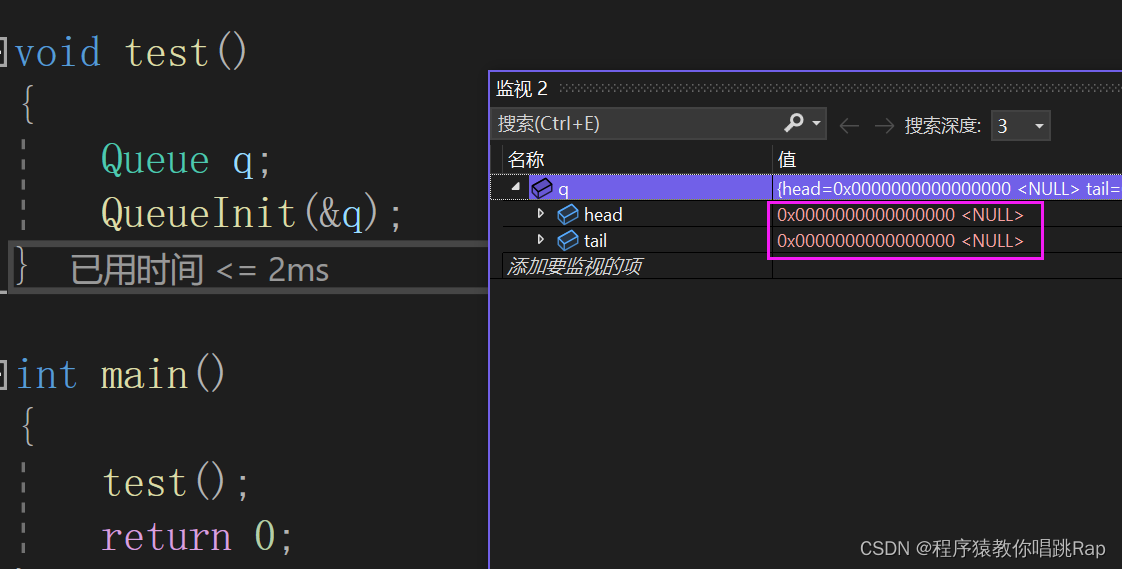
2.3.2 销毁
Queue.h
void QueueDestroy(Queue* pq);//销毁Queue.c
void QueueDestroy(Queue* pq)
{
assert(pq);
QNode* cur = pq->head;
while (cur != NULL)
{
QNode* next = cur->next;
free(cur);
cur = next;
}
pq->head = pq->tail = NULL;
}2.3.3 判空
Queue.h
bool QueueEmpty(Queue* pq);//判空Queue.c
bool QueueEmpty(Queue* pq)
{
assert(pq);
return pq->head == NULL;
}2.3.4 获取队头元素
Queue.h
QDataType QueueFront(Queue* pq);//获取队头元素Queue.c
QDataType QueueFront(Queue* pq)
{
assert(pq);
assert(pq->head);//头部不能为空
return pq->head->data;
}2.3.5 获取队尾元素
Queue.h
QDataType QueueBack(Queue* pq);//获取队尾元素Queue.c
QDataType QueueBack(Queue* pq)
{
assert(pq);
assert(pq->tail);//尾部不能为空
return pq->tail->data;
}2.3.6 获取队列元素个数
Queue.h
int QueueSize(Queue* pq);//获取队列元素个数Queue.c
int QueueSize(Queue* pq)
{
assert(pq);
int n = 0;
QNode* cur = pq->head;
while (cur)
{
++n;
cur = cur->next;
}
return n;
}2.3.7 入队列
Queue.h
void QueuePush(Queue* pq, QDataType x);//入队列Queue.c
void QueuePush(Queue* pq, QDataType x)
{
assert(pq);
//创建一个新结点保存数据
QNode* newnode = (QNode*)malloc(sizeof(QNode));
//暴力检测newnode,因为malloc的都要检测
assert(newnode);
newnode->next = NULL;
newnode->data = x;
//如果一开始没有数据,为空的情况
if (pq->tail == NULL)
{
assert(pq->head == NULL);
pq->head = pq->tail = newnode;
}
else
{
pq->tail->next = newnode;
pq->tail = newnode;
}
}2.3.8 出队列
Queue.h
void QueuePop(Queue* pq);//出队列Queue.c
void QueuePop(Queue* pq)
{
assert(pq);
assert(pq->head && pq->tail);//tail和head均不能为空
//特殊:当删到head=tail位置时,tail会变成野指针
if (pq->head->next == NULL)
{
free(pq->head);
pq->head = pq->tail = NULL;
}
//一般情况
else
{
//保存head的下一个结点
QNode* next = pq->head->next;
free(pq->head);
pq->head = next;
}
}2.4 完整代码展示
Queue.h
#pragma once
#include <stdio.h>
#include <stdlib.h>
#include <assert.h>
#include <stdbool.h>
//创建队列结构
typedef int QDataType;
//创建队列结点
typedef struct QueueNode
{
struct QueueNode* next;//记录下一个结点
QDataType data;//存储数据
}QNode;
//保存队头和队尾
typedef struct Queue
{
QNode* head;//头指针
QNode* tail;//尾指针
}Queue;
void QueueInit(Queue* pq);//初始化
void QueueDestroy(Queue* pq);//销毁
void QueuePush(Queue* pq, QDataType x);//入队列
void QueuePop(Queue* pq);//出队列
QDataType QueueFront(Queue* pq);//获取队头元素
QDataType QueueBack(Queue* pq);//获取队尾元素
int QueueSize(Queue* pq);//元素个数
bool QueueEmpty(Queue* pq);//判空Queue.c
#include "Queue.h"
void QueueInit(Queue* pq)
{
assert(pq);
pq->head = NULL;
pq->tail = NULL;
}
void QueueDestroy(Queue* pq)
{
assert(pq);
QNode* cur = pq->head;
while (cur != NULL)
{
QNode* next = cur->next;
free(cur);
cur = next;
}
pq->head = pq->tail = NULL;
}
bool QueueEmpty(Queue* pq)
{
assert(pq);
return pq->head == NULL;
}
void QueuePush(Queue* pq, QDataType x)
{
assert(pq);
//创建一个新结点保存数据
QNode* newnode = (QNode*)malloc(sizeof(QNode));
//暴力检测newnode,因为malloc的都要检测
assert(newnode);
newnode->next = NULL;
newnode->data = x;
//如果一开始没有数据,为空的情况
if (pq->tail == NULL)
{
assert(pq->head == NULL);
pq->head = pq->tail = newnode;
}
else
{
pq->tail->next = newnode;
pq->tail = newnode;
}
}
void QueuePop(Queue* pq)
{
assert(pq);
assert(pq->head && pq->tail);//tail和head均不能为空
//特殊:当删到head=tail位置时,tail会变成野指针
if (pq->head->next == NULL)
{
free(pq->head);
pq->head = pq->tail = NULL;
}
//一般情况
else
{
//保存head的下一个结点
QNode* next = pq->head->next;
free(pq->head);
pq->head = next;
}
}
QDataType QueueFront(Queue* pq)
{
assert(pq);
assert(pq->head);//头部不能为空
return pq->head->data;
}
QDataType QueueBack(Queue* pq)
{
assert(pq);
assert(pq->tail);//尾部不能为空
return pq->tail->data;
}
int QueueSize(Queue* pq)
{
assert(pq);
int n = 0;
QNode* cur = pq->head;
while (cur)
{
++n;
cur = cur->next;
}
return n;
}test.c
#include "Queue.h"
void test()
{
Queue q;
QueueInit(&q);
//插入数据
QueuePush(&q, 1);
QueuePush(&q, 2);
QueuePush(&q, 3);
//打印数据
while (!QueueEmpty(&q))
{
printf("%d ", QueueFront(&q));
QueuePop(&q);
}
printf("\n");
}
int main()
{
test();
return 0;
}







 本文详细介绍了栈和队列的概念、结构以及它们在C语言中的实现,包括初始化、销毁、入栈、出栈、判空、获取栈顶/队头元素、获取栈中/队列元素个数等基本操作。栈遵循后进先出(LIFO)原则,而队列遵循先进先出(FIFO)原则,文中还给出了栈和队列的完整C代码实现。
本文详细介绍了栈和队列的概念、结构以及它们在C语言中的实现,包括初始化、销毁、入栈、出栈、判空、获取栈顶/队头元素、获取栈中/队列元素个数等基本操作。栈遵循后进先出(LIFO)原则,而队列遵循先进先出(FIFO)原则,文中还给出了栈和队列的完整C代码实现。















 145
145

 被折叠的 条评论
为什么被折叠?
被折叠的 条评论
为什么被折叠?








